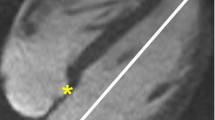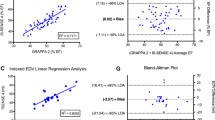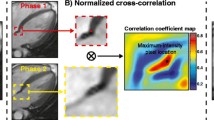Abstract
Objective
As high-field cardiac MRI (CMR) becomes more widespread the propensity of ECG to interference from electromagnetic fields (EMF) and to magneto-hydrodynamic (MHD) effects increases and with it the motivation for a CMR triggering alternative. This study explores the suitability of acoustic cardiac triggering (ACT) for left ventricular (LV) function assessment in healthy subjects (n = 14).
Methods
Quantitative analysis of 2D CINE steady-state free precession (SSFP) images was conducted to compare ACT’s performance with vector ECG (VCG). Endocardial border sharpness (EBS) was examined paralleled by quantitative LV function assessment.
Results
Unlike VCG, ACT provided signal traces free of interference from EMF or MHD effects. In the case of correct R-wave recognition, VCG-triggered 2D CINE SSFP was immune to cardiac motion effects—even at 3.0 T. However, VCG-triggered 2D SSFP CINE imaging was prone to cardiac motion and EBS degradation if R-wave misregistration occurred. ACT-triggered acquisitions yielded LV parameters (end-diastolic volume (EDV), end-systolic volume (ESV), stroke volume (SV), ejection fraction (EF) and left ventricular mass (LVM)) comparable with those derived from VCG-triggered acquisitions (1.5 T: ESVVCG = (56 ± 17) ml, EDVVCG = (151 ± 32) ml, LVMVCG = (97 ± 27) g, SVVCG = (94 ± 19) ml, EFVCG = (63 ± 5)% cf. ESVACT = (56 ± 18) ml, EDVACT = (147 ± 36) ml, LVMACT = (102 ± 29) g, SVACT = (91 ± 22) ml, EFACT = (62 ± 6)%; 3.0 T: ESVVCG = (55 ± 21) ml, EDVVCG = (151 ± 32) ml, LVMVCG = (101 ± 27) g, SVVCG = (96 ± 15) ml, EFVCG = (65 ± 7)% cf. ESVACT = (54 ± 20) ml, EDVACT = (146 ± 35) ml, LVMACT = (101 ± 30) g, SVACT = (92 ± 17) ml, EFACT = (64 ± 6)%).
Conclusions
ACT’s intrinsic insensitivity to interference from electromagnetic fields renders it suitable for clinical CMR.








Similar content being viewed by others
References
Hudsmith LE, Petersen SE, Francis JM, Robson MD, Neubauer S (2005) Normal human left and right ventricular and left atrial dimensions using steady state free precession magnetic resonance imaging. J Cardiovasc Magn Reson 7:775–782
Maceira A, Prasad S, Khan M, Pennell D (2006) Normalized left ventricular systolic and diastolic function by steady state free precession cardiovascular magnetic resonance. J Magn Reson Imaging 8:417–426
Gutberlet M, Schwinge K, Freyhardt P, Spors B, Grothoff M, Denecke T, Ludemann L, Noeske R, Niendorf T, Felix R (2005) Influence of high magnetic field strengths and parallel acquisition strategies on image quality in cardiac 2D CINE magnetic resonance imaging: comparison of 1.5 T vs 3.0 T. Eur Radiol 15:1586–1597
Lima JA, Desai MY (2004) Cardiovascular magnetic resonance imaging: current and emerging applications. J Am Coll Cardiol 44:1164–1171
Niendorf T, Saranathan M, Lingamneni A, Pedrosa I, Spencer M, Cline H, Foo TK, Rofsky NM (2005) Short breath-hold, volumetric coronary MR angiography employing steady-state free precession in conjunction with parallel imaging. Magn Reson Med 53:885–894
Pennell DJ, Sechtem UP, Higgins CB, Manning WJ, Pohost GM, Rademakers FE, van Rossum AC, Shaw LJ, Yucel EK (2004) Clinical indications for cardiovascular magnetic resonance (CMR): Consensus panel report. Eur Heart J 25:1940–1965
Roes SD, Korosoglou G, Schar M, Westenberg JJ, van Osch MJP, de Roos A, Stuber M (2008) Correction for heart rate variability during 3D whole heart MR coronary angiography. J Magn Reson Imaging 27:1046–1053
Sodickson DK, Hardy CJ, Zhu Y, Giaquinto RO, Gross P, Kenwood G, Niendorf T, Lejay H, McKenzie CA, Ohliger MA, Grant AK, Rofsky NM (2005) Rapid volumetric MRI using parallel imaging with order-of-magnitude accelerations and a 32-element RF coil array: feasibility and implications. Acad Radiol 12:626–635
Spuentrup E, Botnar RM (2006) Coronary magnetic resonance imaging: visualization of the vessel lumen and the vessel wall and molecular imaging of arteriothrombosis. Eur Radiol 16:1–14
Lanzer P, Barta C, Botvinick EH, Wiesendanger HU, Modin G, Higgins CB (1985) ECG-synchronized cardiac MR imaging: method and evaluation. Radiology 155:681–686
Fischer SE, Wickline SA, Lorenz CH (1999) Novel real-time R-wave detection algorithm based on the vectorcardiogram for accurate gated magnetic resonance acquisitions. Magn Reson Med 42:361–370
Chia JM, Fischer SE, Wickline SA, Lorenz CH (2000) Performance of QRS detection for cardiac magnetic resonance imaging with a novel vectorcardiographic triggering method. J Magn Reson Imaging 12:678–688
Kugel H, Bremer C, Puschel M, Fischbach R, Lenzen H, Tombach B, Van Aken H, Heindel W (2003) Hazardous situation in the MR bore: induction in ECG leads causes fire. Eur Radiol 13:690–694
Shellock FG, Kanal E (1996) Burns associated with the use of monitoring equipment during MR procedures. J Magn Reson Imaging 6:271–272
Shellock FG, Crues JV (2004) MR procedures: biologic effects, safety, and patient care. Radiology 232:635–652
Stralka JP, Bottomley PA (2007) A prototype RF dosimeter for independent measurement of the average specific absorption rate (SAR) during MRI. J Magn Reson Imaging 26:1296–1302
Stecco A, Saponaro A, Carriero A (2007) Patient safety issues in magnetic resonance imaging: state of the art. Radiol Med 112:491–508
Stuber M, Botnar RM, Fischer SE, Lamerichs R, Smink J, Harvey P, Manning WJ (2002) Preliminary report on in vivo coronary MRA at 3 Tesla in humans. Magn Reson Med 48:425–429
Frauenrath T, Niendorf T, Kob M (2008) Acoustic method for synchronization of magnetic resonance imaging (MRI). Acta Acust United Acust 94:148–155
Bland JM, Altman DG (1986) Statistical method for assessing agreement between two methods of clinical measurement. Lancet 1:307–310
Rangayyan RM, Lehner RJ (1987) Phonocardiogram signal analysis: a review. Crit Rev Biomed Eng 15:211–236
Larson AC, Kellman P, Arai A, Hirsch GA, McVeigh E, Li D, Simonetti OP (2005) Preliminary investigation of respiratory self-gating for free-breathing segmented cine MRI. Magn Reson Med 53:159–168
Larson AC, White RD, Laub G, McVeigh ER, Li D, Simonetti OP (2004) Self-gated cardiac cine MRI. Magn Reson Med 51:93–102
Nijm GM, Sahakian AV, Swiryn S, Carr JC, Sheehan JJ, Larson AC (2008) Comparison of self–gated cine MRI retrospective cardiac synchronization algorithms. J Magn Reson Imaging 28:767–772
Saleem SN (2008) Feasibility of MRI of the fetal heart with balanced steady-state free precession sequence along fetal body and cardiac planes. AJR Am J Roentgenol 191:1208–1215
Snyder CJ, DelaBarre L, Metzger GJ, van de Moortele PF, Akgun C, Ugurbil K, Vaughan JT (2009) Initial results of cardiac imaging at 7 Tesla. Magn Reson Med 61:517–524
Vaughan JT, Snyder CJ, DelaBarre LJ, Bolan PJ, Tian J, Bolinger L, Adriany G, Andersen P, Strupp J, Ugurbil K (2009) Whole-body imaging at 7 T: preliminary results. Magn Reson Med 61:244–248
Author information
Authors and Affiliations
Corresponding author
Rights and permissions
About this article
Cite this article
Becker, M., Frauenrath, T., Hezel, F. et al. Comparison of left ventricular function assessment using phonocardiogram- and electrocardiogram-triggered 2D SSFP CINE MR imaging at 1.5 T and 3.0 T. Eur Radiol 20, 1344–1355 (2010). https://doi.org/10.1007/s00330-009-1676-z
Received:
Revised:
Accepted:
Published:
Issue Date:
DOI: https://doi.org/10.1007/s00330-009-1676-z




